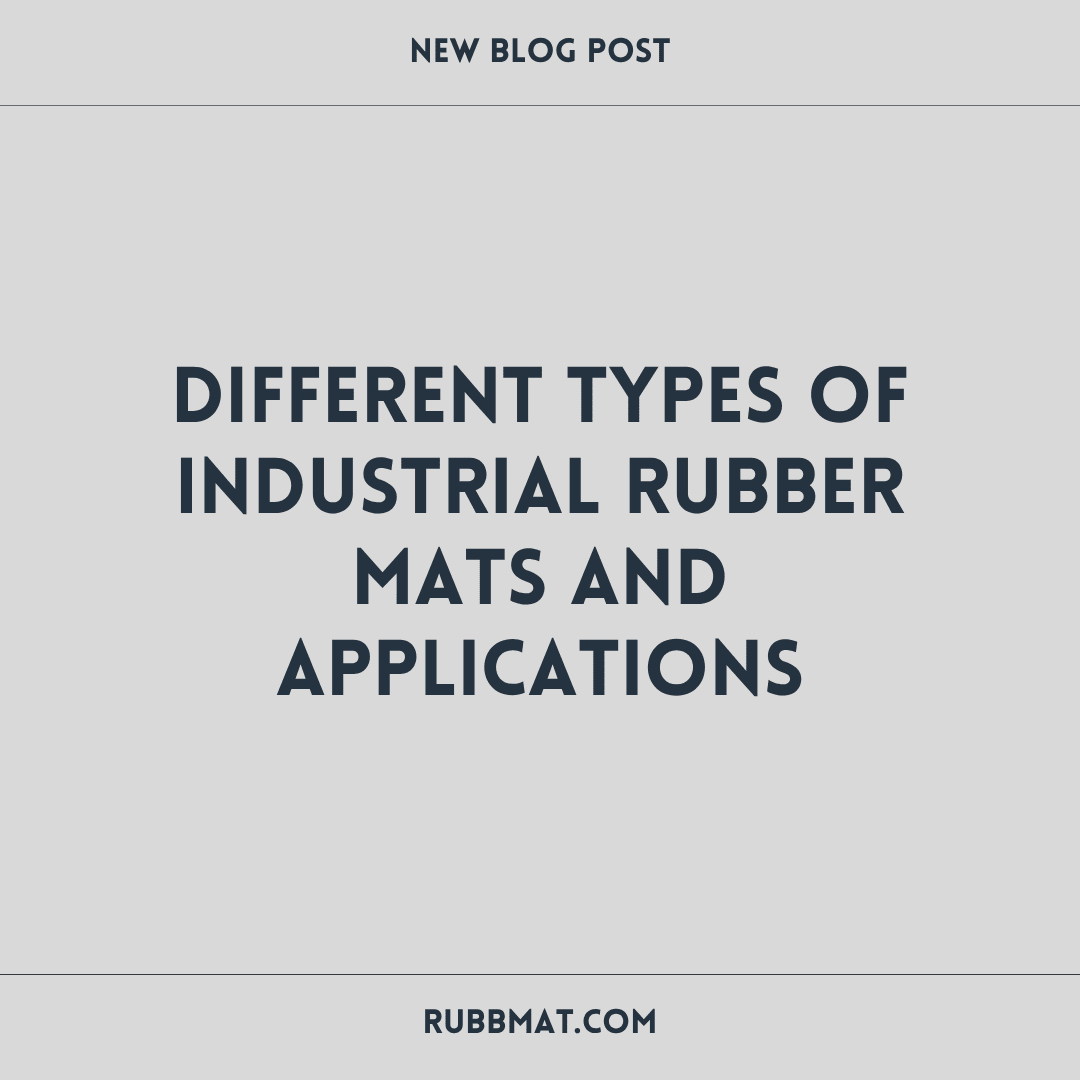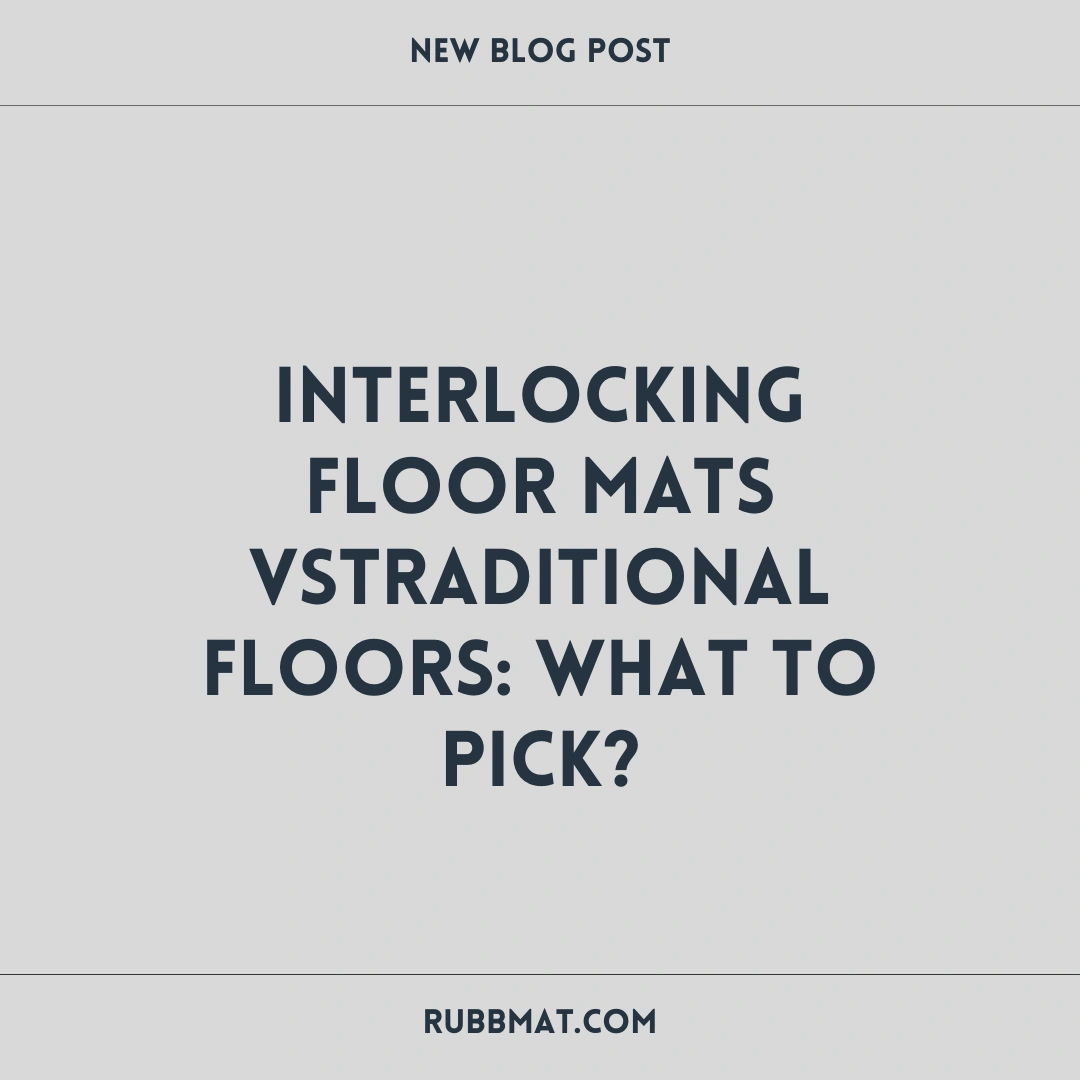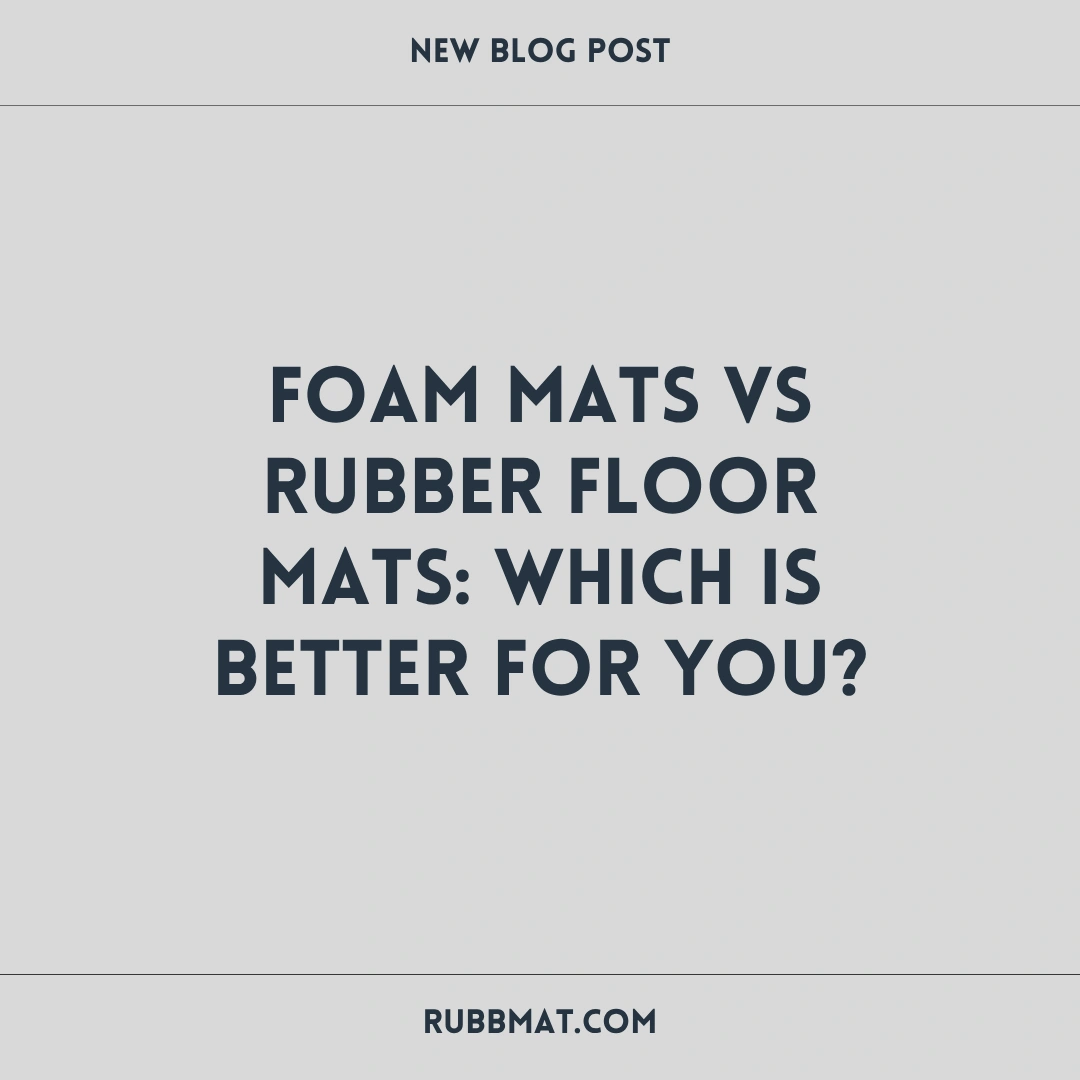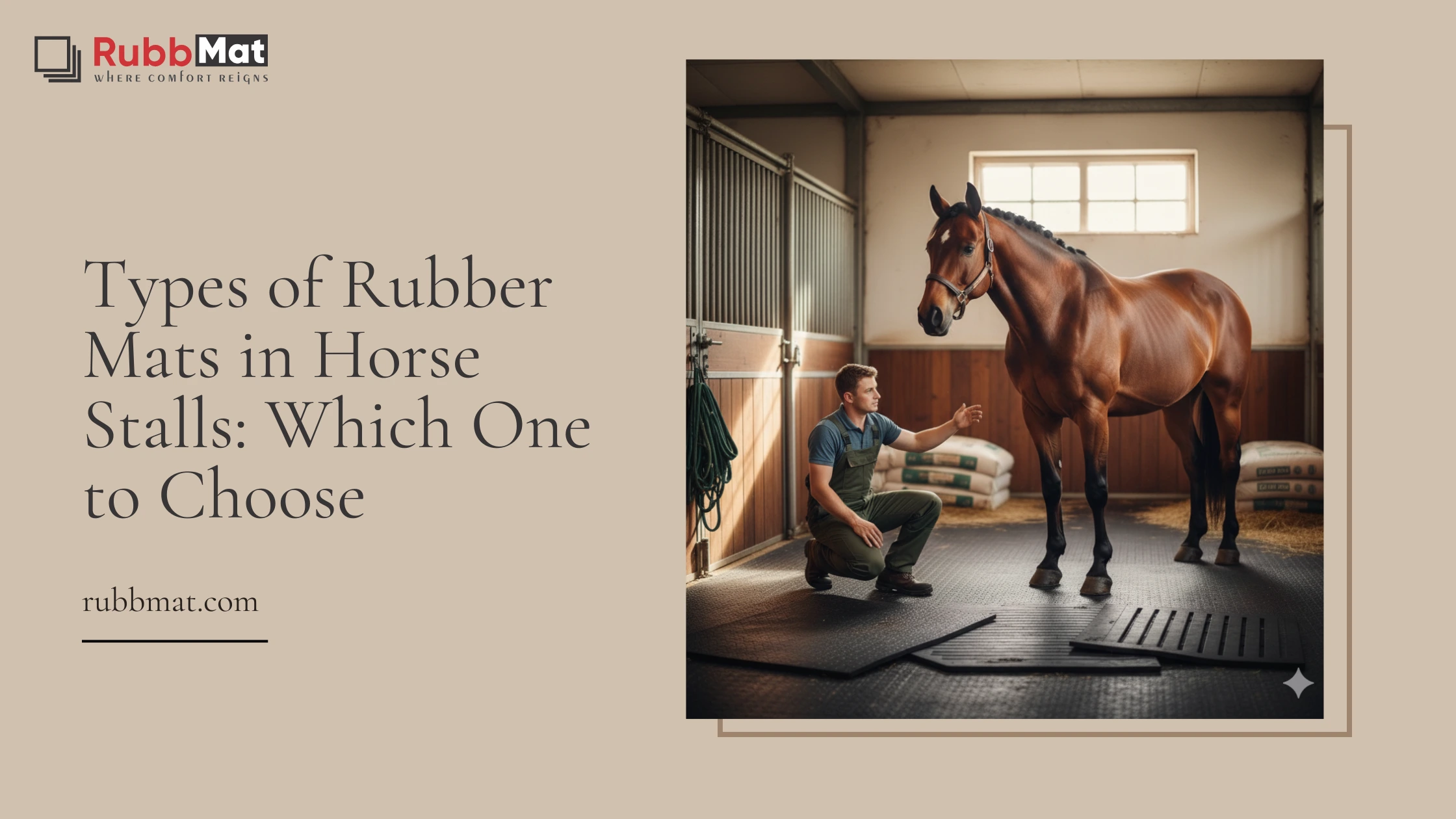
The flooring in the stall of your horse may not be the most glamorous thing when you are thinking about it, but it is one of the most important. How your horse is maintained in terms of the type of floor they are on on a daily basis directly relates to their health, safety and comfort. Rubber mats in horse stalls are one of the alternatives that are noteworthy due to numerous advantages they have. Not every stall horse mat is equal. Here, we shall be discussing the types of rubber mats in horse stalls, how to choose among them, and what matters most for your barn.
What Are Rubber Stall Mats and Why Use Them?
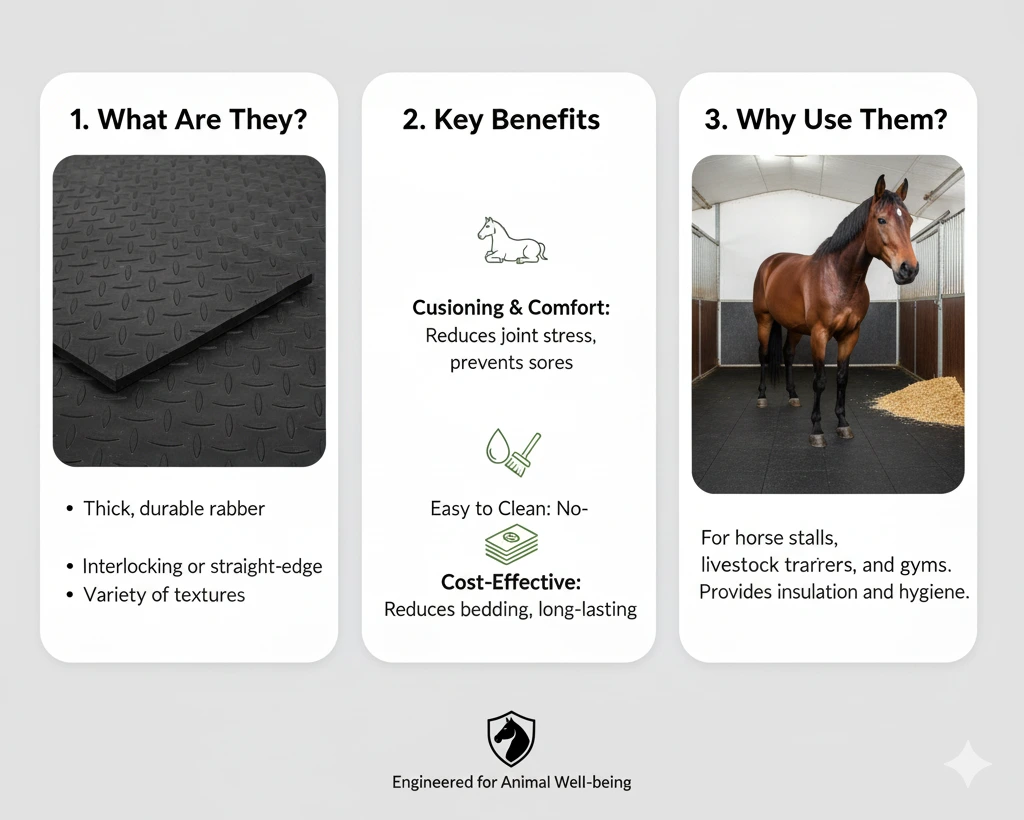
Rubber Stall mats (also known as rubber stall mat flooring, stall mats, and horse mats) are heavy rubber cushions that are laid over a layer of floor, usually concrete, asphalt, or compressed earth. These are designed to cushion, insulate and offer a safe surface to horses in contrast to the hard and bare surfaces. Others are made out of recycled rubber and some have composite materials with foam or textured surfaces.
Using rubber mats for horse stalls improves grip, reduces joint stress, helps manage cold floors, and makes maintenance easier. They also assist in making bedding cleaner and longer and decrease the problems with moisture or uneven floors.
Types of Rubber Mats in Horse Stalls
Here are the main types of horse stable mats, stall mat horse styles and what situations they’re best for:
| Type | Description | Pros | Cons | Best For |
|---|---|---|---|---|
| Straight-edge slab mats | Large, thick single-piece rubber mats (e.g. 4×6) | Few seams, durable, clean look | Heavy, costly, hard to move | Standard stalls needing low maintenance |
| Interlocking mats / tiles | Puzzle-edge sections that lock together | Flexible layout, easy to replace, lighter | More seams trap dirt, uneven joints possible | Irregular stalls, easy replacements |
| Textured / patterned mats | Grooved or raised surface for traction | Non-slip, better grip, attractive | Harder to clean, can trap dirt, pricier | Wet/cold areas, wash stalls, winter use |
| Foam-rubber composite mats | Rubber with foam or soft under-layer | Extra comfort, warmer, less bedding | Less durable under pawing, higher cost | Horses stabled long hours, cold climates |
| Wash-bay / wet area mats | Textured, draining mats for water exposure | Non-slip wet, easy rinse, durable | Rougher surface, more cleaning, costlier | Wash racks, grooming stalls, high moisture |
Key Factors to Consider When Choosing
To choose the right horse stable flooring and equine stable mats, you should compare options across several criteria:
-
Thickness: On average, horse stalls have mats with a range of 10 mm to 25 mm in thickness. More rigid mats (perhaps 20-25 mm or 5/8 inch or higher) are usually better cushioned, not so likely to roll up at the edges, and in many cases long-lasting.
-
Size & Fit: It is necessary to match the size of the stall. Common and manageable standard sizes, such as 4×6 stall mats, are used. Single pieces larger can be used to minimize seams, but are heavy. It may be needed to cut custom-fit mats.
-
Surface Texture & Slip Resistance: Smooth mats are easier to wipe down yet can be slippery, whereas patterned and grooved surfaces provide grip and hold more mess. Apply textured floors where there is a lot of moisture or on wet galleries.
-
Durability & Material: Types of recycled rubber and virgin rubber, as a composite. Find mats that do not crack, crush or wear with heavy use or pawing.
-
Maintenance & Cleaning: How easy is it to clean manure, bedding, etc.? How do seams behave? How will the mat cope with moisture?
-
Moisture & Drainage: Rubber mats alone don’t always solve drainage; subfloor must be well-prepared. Moisture beneath mats can lead to odor, mold, or hoof issues.
-
Cost vs Long-Term Value: The initial cost may be high for slab or textured mats, but savings on bedding, reduced vet bills, better horse comfort can offset cost over time.
Slab or textured mats might be expensive initially, but they can save on bedding, lessen the amount the horse spends on the vet, and increase the comfort of the horse, which can pay off over time.
People Also Ask: Common Questions
Here are questions that often come up (and which can correspond to “People Also Ask” in search results). Answers help clarify common doubts.
What thickness is best for rubber mats in horse stalls?
A thickness between 20-25 mm (roughly ¾-inch) is often ideal for providing comfort, reducing joint stress, and ensuring durability. Thinner mats (10-15 mm) may be suitable in some cases but may wear faster or require more bedding to cushion.
Do rubber stall mats reduce the amount of bedding needed?
Yes. Good quality, thick rubber mats with a smooth or slightly textured surface often reduce bedding demand, because they cushion and insulate. Horses may also paw less deeply, meaning less bedding displacement.
Are interlocking stall mats better than slab mats?
It depends on your priorities. Interlocking mats offer flexibility, easier replacement of sections, and are lighter to handle. But slab mats or full-piece mats have fewer seams (less chance for dirt/urine to collect), fewer trip hazards, and often more sturdiness. Evaluate based on stall layout, how much cleaning you want to do, and how heavy/hard usage the stall gets.
How do rubber stall mats compare against concrete or sand flooring?
Rubber mats are generally much more comfortable for the horse, reducing risk of leg/joint strain, insulating against cold, and improving safety (slipping, standing comfort). Concrete or sealed asphalt floors are durable and easy to clean but can be cold, hard, and require heavier bedding. Sand or clay mixes are more natural but have challenges with drainage, stability, and are more labour-intensive to maintain.
How to maintain horse stable mats so they last longer?
-
Clean regularly: remove bedding, rinse or hose off manure, check seams
-
Avoid sharp edges or materials that could cut rubber
-
Ensure the subfloor is level and well-drained so mats rest flat, reducing curling or edge damage
-
In very wet stalls, allow drying periods or use ventilated mats
-
Replace small damaged sections rather than whole mats where possible
How to Install Rubber Mats Correctly
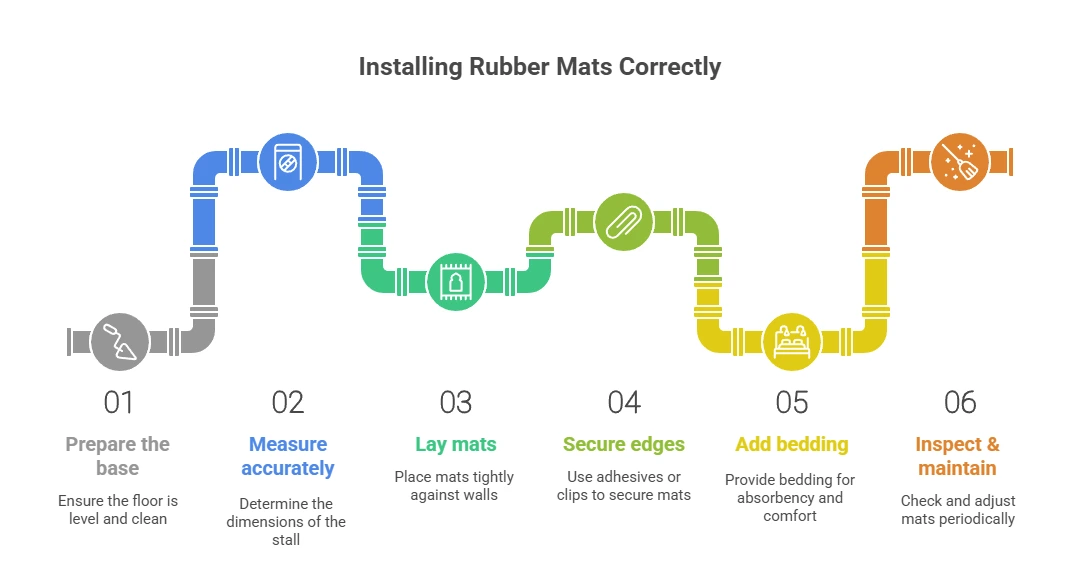
-
Prepare the base: Ensure the stall floor (concrete, compacted dirt, or other foundation) is level, firm, free of debris.
-
Measure accurately: Get interior dimensions of stall, account for walls, doors, etc. Map out which mats go where.
-
Lay mats: Begin at a corner; place large slab or interlocking pieces tight against walls. Ensure seams are tight, no gaps.
-
Secure edges: Use adhesives, wall-edge securing clips if available; bevel edges or use transition strips where needed.
-
Add appropriate bedding: Even with mats, bedding (shavings, straw, etc.) is necessary for absorbency and comfort. With good mats, you may reduce bedding quantity.
-
Inspect & maintain: Check periodically for lifted edges, cracks, curling. Clean and adjust as needed.
Real-World Considerations & Practical Tips
-
Climate matters: In colder regions, thicker mats or foam composite mats help retain warmth.
-
Horse type & usage: Heavy breed, stall time vs turnout hours. A horse that’s in stall a lot needs more comfort and better cushioning.
-
Budget constraints: Sometimes mixing slab mats for high-use areas and interlocking for less used parts gives balanced cost and performance.
-
Try sample pieces: If possible, see and walk on sample mats to test grip, texture, ease of cleaning.
Looking for a Reliable Manufacturer and Supplier?
In selecting the appropriate flooring, collaboration with an honest manufacturer is equally important as the material. Rubbmat is one of the suppliers and manufacturer of horse stall mats that have a wide variety of rubber flooring products in the horse facility. They have such products as Stable and Stall Mats, which are heavy-duty and can be used on a daily basis, Horse Walkway Mats, which are stable enough to maintain safety in the aisles and paddocks, and Horse Shower Mats, which can be utilized in wet conditions. Rubbmat with its various thicknesses and surface textures and sizes, can be used to provide a safer and more comfortable environment to the horses in the barns, once the managers and owners have different thicknesses, surface textures, and sizes available to them, and lower maintenance costs over the long term.
Conclusion
Horse stall flooring, rubber mats are a good investment in the comfort, health and safety of your horse, as well as on your maintenance time in the long-term. It is a matter of personal preference when it comes to selecting slab mats, interlocking tiles, textured surfaces, or foam rubber composites; the most important aspect to consider is the size of your stall, the subflooring, climate, and how much work you are prepared to do.
A basic suggestion, however, is as follows: In most typical stalls, a 4× 6 stall mat or similar slab, of 20-25 mm thickness, good grip on the bottom of the posts, and a slightly textured top will do well. Select interlocking or patterned surfaces in case it is necessary to provide traction or flexible layout; foam composite in case you wish to provide additional warmth.
